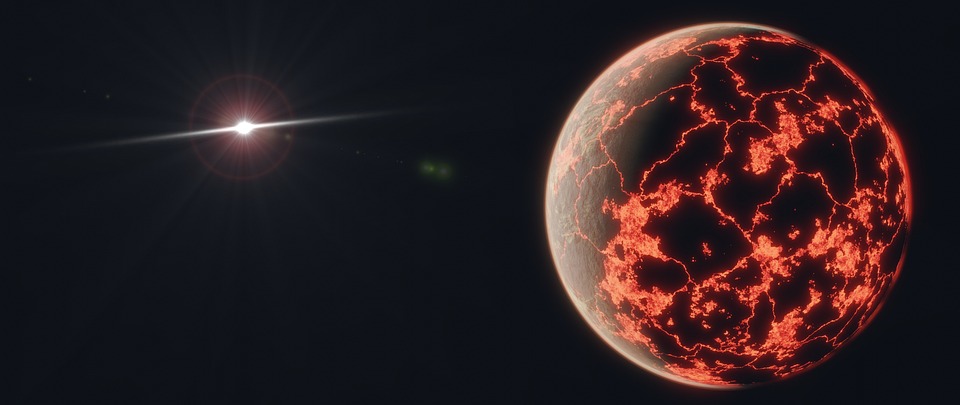Do you know which planet is the hottest in our solar system? Did you know that Mercury, according to popular belief, is not the hottest planet in the solar system? That is precisely what we are attempting to convey to you through this video. Because Mercury is the nearest planet to the Sun, many people believe it to be the hottest planet in the solar system. This, however, is not the case. Venus, the second planet from the Sun, has the highest temperature. You may be wondering why Venus is hotter than Mercury, despite the fact that Venus is not as near to the sun as Mercury is. Let's figure out why!
Why is Venus the Hottest Planet and not Mercury?
Despite not being the nearest planet
to the Sun, Venus is the hottest planet in the solar system. Why? Because Venus
has a thick atmosphere, or a layer of gas around the planet. The planet's dense
atmosphere absorbs heat and prevents it from escaping back into space. This
phenomenon is known as the "greenhouse effect," and it causes Venus's
surface to be hotter than that of Mercury and all other planets in the solar system.
Introduction to Venus
Venus is one of the eight planets in
our Solar System that circle the Sun. It is Earth's closest neighbor and the
second planet from the Sun. The average distance between the Sun and Venus is
approximately 67 million miles (108 million kilometers). When viewed from
Earth, Venus is the hottest planet in the solar system and the brightest planet
in the sky.
Surface and Structure
Venus is a planet that exists on
Earth. It's rough and sturdy. The plains cover the majority of Venus's surface.
Mountains and hills are uncommon. Lava flows cover a large portion of the
surface. On Venus, there are several big volcanoes. "Sif Mons" is the
name of one of Venus's greatest volcanoes. In truth, Venus still has several
active volcanoes on its surface. Furthermore, scientists believe Venus
possesses layers similar to those seen on Earth. The layers consist mostly of a
metal core, a rocky middle, and a crust.
Size
Venus is almost the same size and
weight as Earth, but it is somewhat smaller. It has a diameter of around 12,100
kilometers. It is the second-largest terrestrial planet after Earth, and the
sixth-largest planet in the solar system overall.
Venus is approximately three times the
size of Mercury, the solar system's smallest planet. It is, nevertheless, about
11.8 times smaller than Jupiter, the largest planet in the solar system. Around
1400 planets the size of Venus might fit within Jupiter. Venus is roughly two
times the size of Mars.
Read More Articles
Read More — How Many Planets are in our Galaxy?
Read More — How Big Is The Milky Way?
Read More — Do You Know What Is At The Center Of The Milky Way?
Atmosphere and Temperature
Venus is enveloped by a dense
atmosphere made mostly of the greenhouse gas carbon dioxide. There are also
heavy sulfuric acid clouds engulfing the globe. The gases and clouds trap heat,
keeping Venus warm. The temperature at Venus's surface is around 867° F (464°
C). The temperature is high enough to cause lead to melt. Furthermore, the
thick and dense atmosphere creates extremely high pressure. The pressure on
Venus is 92 times that of Earth, enough to crush many objects.
Scientists believe Venus's atmosphere
may have been similar to Earth's billions of years ago. There might have also
been a lot of water on Venus's surface. However, after billions of years,
evaporation of water generated a greenhouse effect, resulting in a large amount
of greenhouse gases in its atmosphere.
Orbit and Rotation
Venus moves in two directions:
orbiting the Sun and spinning around its axis. Venus's orbit around the Sun
takes 225 Earth days, hence a year on Venus lasts 225 Earth days. Venus' orbit
is roughly circular, not elliptical like that of other planets. As a result,
when Venus and Earth are on the same side of the Sun and Venus is between the
Sun and Earth, Venus comes closest to Earth. In this condition, the average
distance between Venus and Earth is around 41 million kilometers. This is the
closest any other planet can come to Earth.
Venus rotates or spins about its axis
while circling the Sun. It does, however, revolve in the opposite direction as
most planets. This is known as a retrograde rotation. Furthermore, Venus spins
quite slowly. It really has the slowest rotational speed of any planet. It
rotates once every 243 Earth days, hence a day on Venus lasts 243 days. As a
result, the day on Venus is longer than the year.
You may wonder why Venus rotates
backwards!
Read More Articles
Read More — Is Pluto a Planet Again?
Read More — 20 Interesting Facts about Venus
Read More — How Does Our Sun Stand Up To and Compare With Other Stars
Read More — Facts about solar system
Discovery and Exploration
People have recognized Venus since ancient times since it can be seen without a telescope from Earth. Additionally, more than 20 unmanned spacecraft have visited Venus, including:
- In 1962, the American spacecraft "Mariner 2" flew close to Venus, making it the first spacecraft to do so.
- In 1970, the Soviet Union's spacecraft "Venera 7" successfully landed on Venus, becoming the first spacecraft to do so.
- In the 1990s, the American spacecraft "Magellan" detailed surveyed the surface of Venus.
- In 2005, the European Space Agency launched a probe to explore the atmosphere of Venus.






0 Comments
Please reach out to me and let me know if you have any certain questions or concerns.